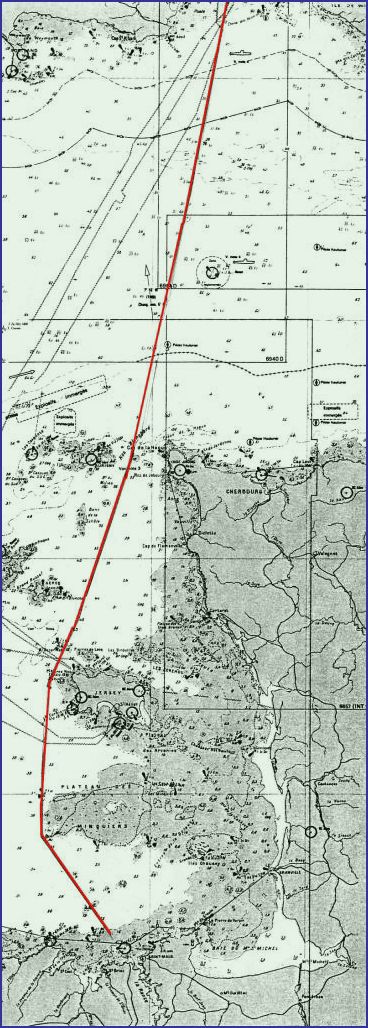|

|
It was 10 p.m. on the 17th when Hilda
sailed out of Southampton bound to Saint Malo with 103 passengers on board. The
fog patches that had delayed the departure became soon a thick fog necessitating
the ship to be anchored around 11 p.m. off Yarmouth, Isle of Wight, until the
visibility improved. At 6 in the morning of 18th, with better weather conditions
the voyage was resumed.
Crossing the Channel was made
under full speed in fine and clear weather conditions until reaching the Race of
Alderney at half past noon. However, gradually those good conditions changed to
a fresh easterly wind and a rough sea after passing Jersey. Mile after mile,
both wind and sea became stronger while the ship was ploughing towards
Saint Malo. Heavy clouds soon covered the sky when in the meantime atmosphere
was becoming colder.
Around 6 p.m., Hilda was
maneuvering to enter the harbour roads, heading for the Jardin Lighthouse. It
was dark and lights from the town were clearly visible but soon came a heavy
snow squall extinguishing all the lights. Immediately Captain Gregory ordered
the boat to starboard, steering a new course to northwest and reduced speed.
That was all he could do without a clear sight of the lighthouse and the coast.
Just wait until improved conditions.
What happened exactly on board between
that time and the time of the accident is not fully known. We only know
that in several occasions, the Jardin Lighthouse came in sight for short
periods necessitating Gregory to abort each time every attempt he made
to enter the Roads. According the survivors, shortly before 11, the
lights of Le Jardin were clearly seen but a few minutes later the Hilda
was violently smashing on the reefs located a few hundred yards west of
the entrance channel to the harbour. Navigational error ? Wrong
appreciation of the drifting angle ? Both, wind and tidal current were
pushing to west but Gregory was a cautious navigator with years of
experience in cross-Channel runs... We have to consider however what can
have been the pressure over him. Due to the delay, he had few chances to
enter the harbour before the tide was too low, what meaned they would
spend the night out at sea until the next morning, passengers situation
was rude, many of them being badly seasick. For those reasons or others,
did he took a risk ? Hard to say, and he will never come back to explain
what happened.
Whatever the reasons, the Hilda was stranded on the reefs and with the
ebb, the situation of the ship could only worsen. An attempt to lower
the boats was made but except one, all the others were either smashed by
the sea or could not be lowered due to the rocks. In such conditions,
without assistance from the shore, it could only turn to a tragedy. The
empty boat together with dozen of bodies will be found the next morning
on the beach at Saint Cast, some 15 miles west of Saint Malo.
In fifteen minutes time, the fate
of the Hilda was sealed. The ship broke in two parts, the forepart
rolling over one side of the reef, the after one foundering in the
western edge but due to to little depth, the wreck was not submerged,
allowing some 20 people to find a refuge in the rigging. They will
remain there all night long, dying from exposure or exhaustment one
after one. It is there that the Ada will find them at 9 in the
morning. Only six people had survived the frightening night, among them
one crew member, James Grinter.
The toll was heavy, 125 out of 131 people on
board had died ! and during the following days, mainly at Saint Cast,
the tide was to bring more bodies on the beaches. The last body was
found in January but they were not all
recovered
and a few ones have had only
the sea for grave.
|